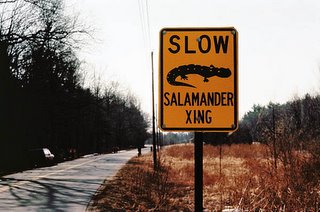
Lest you think the Lawrence salamander rescuers are an odd lot, a quick Google search using salamander migrations as search terms reveals the following links and tidbits:
Salamander Crossing(http://www.artworking.com/salamander/index.htm) discusses a mass migration of amphibians in Brattleboro Vermont and the activities of salamander rescuers:
"Environmental groups in the region report that a large-scale salamander migration, with creatures numbering in the hundreds, took place during Tuesday evening's rainstorm.
"Some were running right across the road, others were just taking their time," said Betsy Bennett, curator and educator of the Grafton Nature Museum. "We helped some of them across the road when cars came. It was really fun."
As temperatures reached the 50s during the downpour, about 10 local citizens came out to witness the natural spectacle, Bennett said. Museum officials and local residents watched the migration take place at a beaver brook on Townshend Road."
Jug Bay Wetlands Sanctuary near Washington DC (http://www.jugbay.org/jugbay/research/marbled.html) conducts research documenting migrations of the marbled salamander Ambystoma opacum shown in the accompanying picture from their web site.
Karen Luepke (http://www.nmu.edu/biology/Jill/Migration/Migration%20Pages/salamander/index.htm) provides a nice discussion of migration in the spotted salamander, Ambystoma maculatum, along with helpful links. She note several things about salamander migrations. First the migrations are very predictable from year to year and at least for the spotted may require more than just the right weather. Also the salamanders seem to be very faithful to the pond they were born in and never stray far, only to about 200m from the pond.
The Federal Highway Administration reports (http://www.fhwa.dot.gov/environment/wildlifecrossings/salamand.htm) on the building salamander tunnels in Amherst MA, not too far from where I grew up. See also http://www.fhwa.dot.gov/environment/wildlifecrossings/.
As for the homing aspect of migration between the breeding pond and feeding areas, some writers hypothesize a scent component but in newts at least, experimental evidence suggests that magnetic orientation analogous to that used by some birds in migration may be used. See Phillips, JB 1986 Two magnetoreception pathways in a migratory salamander. Science Aug 15;233(4765):765-7 (Abstract). Of course it is quite possible that several different orientation cues are involved.

2 comments:
I recently had the opportunity to handle and examine a spotted salamander- they are quite the cuties!
Yes they are! And they make good long lived pets as well. Though I suppose given the decline in amphibian populations, keeping them as pets is not such a good idea. But when I was in junior high one did not worry about large numbers of a single class of animals going towards extinction all at once.
Paul
Post a Comment